16. April 2021 | Series "Covid-19 crisis: consequences for the labour market"
European labour market dynamics after the outbreak of the Covid-19 crisis

Unemployment rises
As a first step, we look at the recruitment (unemployment to employment) and layoffs (employment to unemployment) associated with unemployment. Figure 1 shows these two flows over the past ten years. It is noticeable that the number of recruitments was always greater than the number of layoffs during this period. In the second quarter of 2020, this relation reversed drastically.
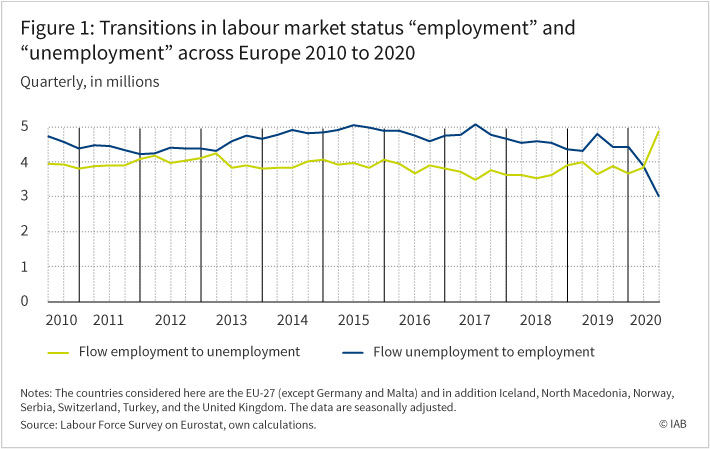
More redundancies into unemployment
Out of all individuals in Europe who were employed in the first quarter of 2020, 4.8 million moved into unemployment in the second quarter of 2020. That is 1.2 million more than in the same quarter of the previous year. This means that the impact of the Covid-19 crisis on layoffs is already considerably stronger within one quarter than it was the case in all quarters of the eurozone crisis in the years 2010 to 2013.
Short-time work – the means of choice against layoffs
The fact that unemployment has not increased even more dramatically in the EU-27 countries is due to the extensive use of short-time work as shown by Georg Fischer’s and Günther Schmid’s 2020 study as well as by Britta Gehrke’s and Enzo Weber’s 2020 study. As macroeconomic research shows, short-time work can be an effective measure to prevent job losses and avoid unemployment in severe recessions.
The European Commission has recognised the importance of short-time work with its proposed “Support to mitigate Unemployment Risks in an Emergency” (SURE) – programme. With this crucial element of the European strategy to combat the Covid-19 crisis, the Commission wants to support national short-time work and similar systems with an amount of 100 billion euros. There were more than 42 million applications for support for workers on short-time work or similar schemes in the EU-27 by the end of April 2020, according to calculations by the European Trade Union Institute (ETUC). That corresponds to about one quarter of the overall EU workforce. In terms of the absolute number of applications for short-time work, France is leading with 11.3 million (47.8 % of employees), followed by Germany (10.1 million, 26.9 %) and Italy (8.3 million, 46.6 %). Although the programmes for short-time work at national levels have a common objective, they differ markedly in their designs, as a 2020 study by Regina Konle-Seidl shows.
Fewer recruitment
The Covid-19 crisis affects not only those who become unemployed but also individuals who are already unemployed or inactive and are currently struggling to find employment again. Three million of those unemployed in the first quarter of 2020 were recorded as employed in the second quarter of 2020 (see Figure 1). That is 1.8 million fewer people than in the same quarter of the previous year. This decrease is already considerably stronger within this quarter than the quarterly change over the entire period from 2010 to 2013. Recruitment figures already dropped in the first quarter 2020, when firms had barely started to react with layoffs. The new hire effect on unemployment is clearly larger than that of layoffs. In addition, there is fewer recruitment from inactivity (persons who were neither unemployed nor employed). Their number fell by 928,000 in the second quarter of 2020 compared to the same quarter of the previous year (see the change of light blue line in Figure 2).
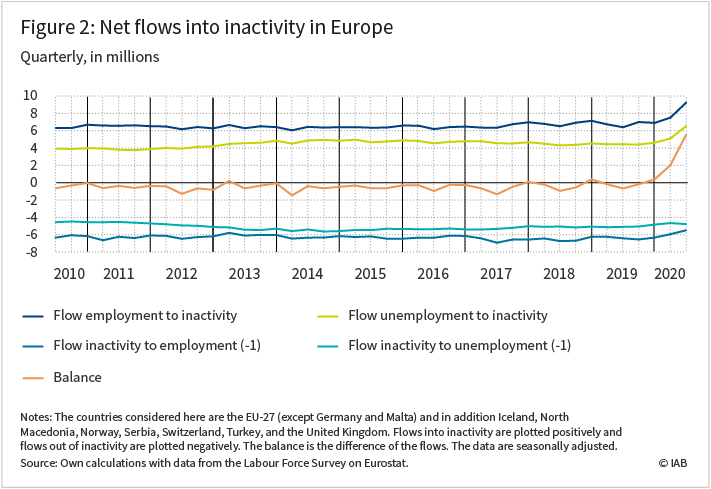
Increasing withdrawal from the labour market
Persons who cannot find new employment in the foreseeable future are at risk of withdrawing from the labour market. The flows into inactivity (positive net balance) and out of inactivity (negative net balance) over the last ten years show a striking increase in the first two quarters of 2020 (see Figure 2). During the first and second quarter, more than 7.5 million people have withdrawn from the European labour market. During the eurozone crisis, such a decline was not apparent.
A comparison with the same period of the previous year shows that 3.6 million more people withdrew from employment (change of dark blue line) and 2.8 million from unemployment (change of green line), respectively in the first two quarters of 2020. That is 6.4 million more people who do not participate any more in the labour market. The second quarter of 2020 alone accounts for 4.9 million.
Men and women leave the labour market
An analysis of the socio-economic composition regarding citizenship, education, age, and sex allows us to have a more detailed look at the distributional consequences of the Covid-19 crisis. A useful measure to show percentage changes in the labour force stock by category is the activity rate. This rate describes the percentage of the labour force (number of employed and unemployed persons) in relation to the total population. In general, it can be said that there has been a withdrawal in all categories, especially during the second quarter of 2020, with women only slightly stronger affected than men.
Foreigners more affected than nationals
The impact on groups of different nationalities was not uniform. The negative changes in activity rates in all three groups show that workers have withdrawn from the labour market in the second quarter of 2020 compared to the same quarter of the previous year. This is more or less pronounced depending on the citizenship. For EU nationals, the change of activity rates was more than twice as high as the change of activity rates for nationals and higher than the decrease in activity rates for migrant groups from third countries (see Figure 3).
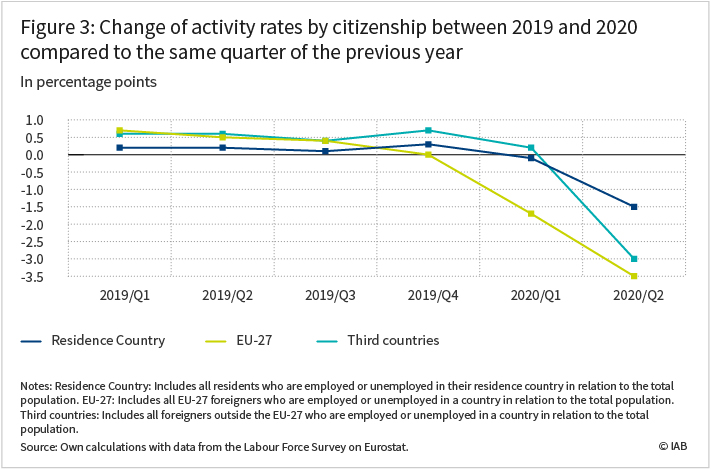
A 2020 study by the OECD comes to the conclusion that in times of slack labour markets, immigrants are particularly affected due to their generally less stable employment conditions and lower job tenure. The authors attribute this to the fact that immigrants are largely overrepresented in a number of services and cyclical sectors, which the pandemic hits more strongly (e.g., hospitality, security, and cleaning services).
Following a record-high inflow of immigrants to European countries during the 2015/16 refugee crisis, recognising qualifications or changing professions is still proving difficult. Additional administrative burdens and language barriers may further discourage employers from hiring migrants under these difficult economic conditions as a 2015 study by Stijn Baert et al. shows. Possibly less familiar with or discouraged by the administrative processes of job-seeker registration during this difficult labour market situation, laid-off migrants and job-seekers may be reluctant to register and may have withdrawn from the labour force altogether.
High-skilled workers are least affected
Even though all economic sectors are affected by the pandemic, labour-intensive sectors have been most dramatically disturbed. Public life has been brought to a standstill by the pandemic. Primarily the retail trade, leisure and recreation services, hotel, restaurants, and accommodation were forcefully closed and thus directly affected by the containment measures. In many EU countries, these sectors are characterised by temporary employment contracts and low salaries, with an above-average number of low-qualified employees.
The negative changes of activity rates by different educational attainment levels show that workers across all levels have withdrawn from the labour market in the second quarter of 2020 compared to the same quarter of the previous year. The change of activity rates was 57 percent and 71 percent higher for those with low and medium level of education, respectively, than for those with high level of education (see Figure 4). The chart shows that the change of the activity rate of people with low qualifications was 11 times higher in the second quarter of 2020 than it was a year earlier. For those with medium-level qualifications, the change is 8 times higher.
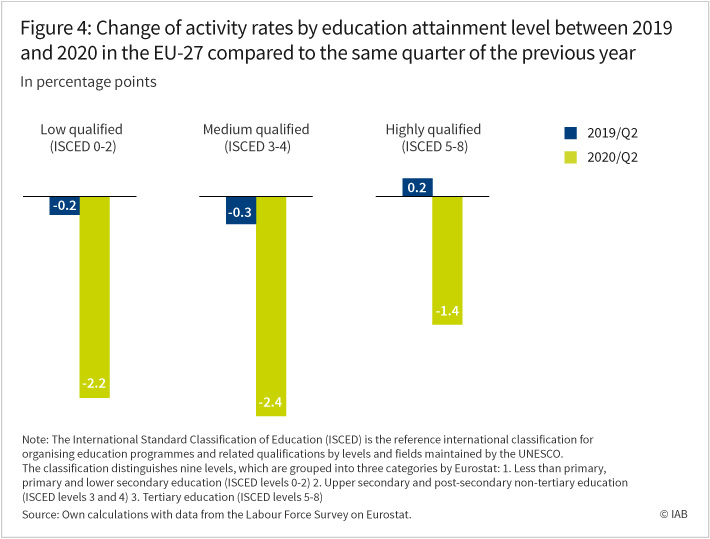
Furthermore, the pandemic led to the breakdown of global supply chains. Production capacities were not fully utilised, production and exports declined. Economic sectors that are largely non-essential, only partially active and not teleworkable are very strongly affected by the measures and suffer a significant blow because of the economic contraction, as Marta Fana et al. show in their 2020 study. This includes the majority of the manufacturing sector such as the automotive industry or mechanical engineering with predominantly medium-qualified workers.
In contrast, the service sectors which involve little degree of social interaction restrictions imposed by confinement measures are not impaired, because they lend themselves to working from home. Examples are professional, scientific, and technical activities, which are characterised by a high share of high-skilled workers in most countries.
Young people are more affected than other age groups
The negative changes in activity rates in the three age groups show that workers have withdrawn from the labour market in the second quarter of 2020 compared to the same quarter of the previous year. This is more or less pronounced depending on the age. The youth labour market, in particular, is highly sensitive to economic cycles. As our evaluation shows, in times of this economic crisis youth participation is more affected than adult employment. A relatively high proportion of young workers is employed in forcefully closed sectors with temporary contracts and atypical forms of work. In addition, the percentage of young workers active in the sectors less affected by the crisis (the essential and the teleworkable sector) is comparably low.
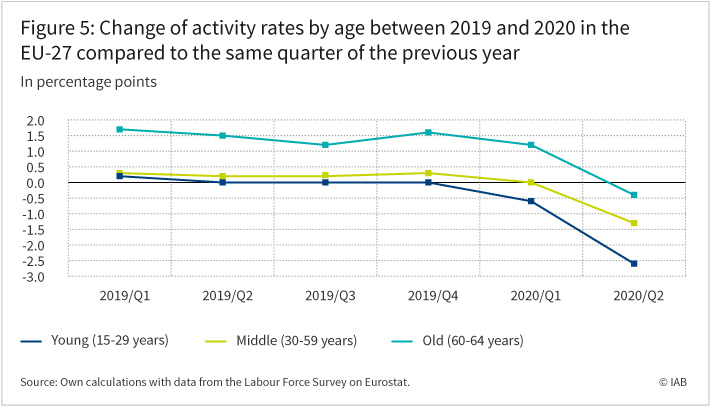
A 2020 study by Bernhard Christoph et al. at the University of Regensburg examined the effects of the pandemic on employed students. It comes to the conclusion that across all economic sectors, the proportion of employed students whose jobs may have been jeopardised by the consequences of the crisis is at 37 percent. In addition, students could also – intentionally or not – delay completing their higher education due to the current labour market situation. This means that in many cases young university graduates will be fully available to the labour market only at a later date.
Generally, the change of activity rates declines with increasing age. In comparison to other age groups, senior workers are less affected by the measures. In their 2020 study, Marta Fana et al. attribute this to the fact that older workers are overrepresented in essential sectors, which are less affected by restrictions than forcefully closed ones. However, as Figure 5 shows, the moderate change of the activity rate in the older age group is also due to the previously existing positive trend that vanished in the crisis; when considering the difference in the annual changes within and before the crisis, the old- and middle-aged groups are similarly affected.
Conclusion
With the beginning of the Coronavirus pandemic, the labour market in Europe came under severe pressure. The analysed charts and figures clearly show that the economic crisis hit the labour market in Europe much harder than the eurozone crisis in the years 2010 to 2013 – at least in the short term.
Layoffs have increased and recruitment has decreased. Above all, many have withdrawn completely from the labour market. During the second quarter of 2020, there were 1.8 million more layoffs, 2.7 million less recruitment and 5.5 million more people who withdrew from the labour market compared to the same quarter of the previous year. Withdrawals are particularly noticeable among low- and medium-skilled workers, young workers and workers from abroad, but also high-skilled ones are concerned.
In the long term, the decisive factor will be whether those who have now been lost to the labour market withdraw permanently and whether labour market slack will exert long-lasting hysteresis and scarring effects – i.e. whether unemployment will become structural and negative unemployment experiences will worsen future labour market possibilities. Therefore, the willingness of companies to hire is key and should be strengthened during the crisis. Reactivating both hiring dynamics and labour market participation is a crucial task on the way out of the crisis.
Data and methods
Our evaluation is based on the data of the EU Labor Force Survey (EU-LFS) on Eurostat.
In order to determine how strongly the crisis affected particular labour market states, we used the data set on the quarterly labour market transitions (lfsi_long_q). This quantifies the quarter-on-quarter transitions of the population of working age (15 years and older) between the three labour market states of employment, unemployment (both states together make up the so-called ‘labour force’) and labour market inactivity. We looked at six different transitions since records began in the second quarter of 2010. Figure 1 deals with layoffs into unemployment and recruitment out of unemployment, Figure 2 shows the flows in and out of inactivity.
The analysis of the labour market transitions considers the following countries: 25 of the 27 Member States of the European Union (except Germany and Malta, due to non-availability), the United Kingdom, three EFTA countries (Iceland, Norway, and Switzerland) and three EU candidate countries (North Macedonia, Serbia, and Turkey).
In a second step, we used the data set on the quarterly European activity rates (lfsq_act) to explain the withdrawal of economically inactive persons in more detail (Figure 2). Activity rates show the percentage of the labour force in relation to the total population. A distinction was made between the important socio-demographic characteristics of citizenship, education level, age, and sex and the change of activity rates compared to the same quarter of the previous year were calculated. These figures are available for all 27 member states of the European Union.
Literature
Baert, Stijn, Bart Cockx, Niels Gheyle, and Cora Vandamme (2015): “Is There Less Discrimination in Occupations Where Recruitment Is Difficult?”, ILR Review 68, No. 3, pp. 467–500.
Christoph, Bernhard, Nele Jugenheimer, Malte Sandner, and Ipek Yükselen (2020): “To Work or Not to Work ? A Case Study on the Structure of Student Employment and Its Possible Effects on Students’ Jobs during the Corona Crisis”, IAB-Forum, 20.11.2020.
Fana, Marta, Songul Tolan, Sergio Perez Torrejón, Maria Cesira Urzi Brancati, and Enrique Fernandez Macias (2020): The COVID Confinement Measures and EU Labour Markets COVID & Empl Working Group. European Commission.
Fischer, Georg, and Günther Schmid (2020): “Arbeitslosigkeit in Europa und den USA unter Covid-19 : Besser im Korsett einer Versicherungslogik eingeengt oder den Launen eines Präsidialsystems ausgeliefert ?”, Discussion Papers, Emeriti EME No. 1/2020, WZB Berlin Social Science Center.
Gehrke, Britta, and Enzo Weber (2020): “Short-Time Work, Layoffs, and New Hires in Germany : How the Corona Crisis Differs from the Financial Crisis of 2009”, IAB-Forum, 16.12.2020.
Konle-Seidl, Regina (2020): “Kurzarbeit in Europa: Die Rettung in der aktuellen Corona-Krise?” Forschungsbericht, No. 04/2020.
OECD (2020): “What Is the Impact of the COVID-19 Pandemic on Immigrants and Their Children?” Tackling Coronavirus (COVID-19), No. 1, 26.10.2020.
Merkl, Christian, and Weber, Enzo (2020): Rescuing the labour market in times of COVID-19: Don’t forget new hires! VoxEU, accessed on 7.4.2020.
Weber, Enzo; Neupert, Roman (2021): European labour market dynamics after the outbreak of the Covid-19 crisis, In: IAB-Forum 16th of April 2021, https://www.iab-forum.de/en/european-labour-market-dynamics-after-the-outbreak-of-the-covid-19-crisis/, Retrieved: 26th of April 2024
Authors:
- Enzo Weber
- Roman Neupert

 Professor Enzo Weber is Head of the Research Department "Forecasts and Structural Analyses" at the IAB. He develops current policy proposals for labour market and economic challenges and advises national and international governments.
Professor Enzo Weber is Head of the Research Department "Forecasts and Structural Analyses" at the IAB. He develops current policy proposals for labour market and economic challenges and advises national and international governments. Roman Neupert worked as an intern in the research department “Forecasts and Macroeconomic Analyses” at the IAB.
Roman Neupert worked as an intern in the research department “Forecasts and Macroeconomic Analyses” at the IAB.